Musings from the Combat Pits
F2D
Getting Ready for March Madness
Preparation
March 2018
By Buzz Wilson and Gene Pape
This is the first in a series of articles about Gene Pape and myself deciding to go to the March Madness Combat contest in Phoenix, Ariz..
Having reached that point in life where I may be referred to as spavined (look it up), you might be asking why are you doing this. Simple: Because I still can.
This series will cover preparation, trip, trauma (hopefully a short article), and post-trip cleanup.
The first decision we had to make was to drive or fly. Two days of driving or a quick flight. Decision made – fly. Next decisions how big a rental car – midsize. Don’t want to make the planes uncomfortable.
Where to stay – where everybody stays. Interesting side note: The facility only cleans the room once a week unless you ask and pay an extra fee. Obviously this place has dealt with traveling model airplane flyers before. Nothing like trying to get brake cleaner and dirt out of a sink.
First let me say that traveling, regardless of where or what you are going to do, is a pain.
The last time I traveled to a contest via air was the Top Gun contest in Tucson, Ariz. Although it was after 9/11, it was fairly simple. Take my plywood crate with airplanes to UPS and ship them to the hotel. Arrange for fuel to be shipped, and pretty much everything else went as luggage – no bag fees or limits. The only problem I remember was that Jeff Rein had a problem trying to carry on his electric drill that he uses to remove the lid from his shipping box. I went onto the TSA website to check what you can carry on versus what you have to check versus what you cannot take. I know of one Combat flier who takes his fuel on as baggage and calls it popcorn oil. The TSA site is alphabetized and when I clicked on “A” the first entry was Adult Toys – nowhere were F2D airplanes listed as adult toys.
That reminds me of a story of a friend of mine and his wife coming back into through U.S. Customs when for some reason the wife’s bag began to make vibrating sounds. Customs must be zapping bags with some form of electronics.
The first thing that I need to do is get a shipping box that I can take as luggage. I am told that a lot of traveling fliers are using a cardboard box that FedEx uses to ship golf bags. Greg Machen brought his FedEx golf club box out to the flying field and I took lots of photos.
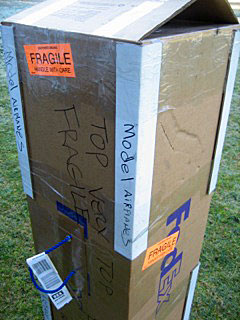
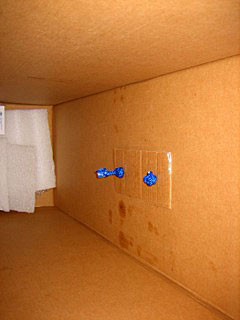
Next, it was off to the FedEx to get one. Greg used cardboard pallet edge guards to reinforce his. I went to a couple of places that receive pallets of materials but they did not have any. I did find them on line at Grainger, but the local Grainger store had been shut down. The price to ship them from Grainger online was more than the product. I have a self-imposed rule. I will not pay more for shipping than the cost of what I am buying. I needed welding rod for pushrods and off to the welding supply store. I asked if they might have some guards from pallets that they receive and they sent me Dumpster diving and I now have two pallet edge guards.
Next up was getting tape to put this thing together. For $15, the local Ace had a six-pack of tape. I missed the added label on the tape that said stickiness was optional. With box in hand, I went onto the Internet for instructions on how to wrap a mummy. Most of these articles dealt with blood and organ removal. What I wanted was to protect my airplanes from “ramp apes.” I will not go into the details of the process, but will let the pictures speak for themselves. Well, maybe a little detail. You notice the ice pick stuck in the box. It is used to locate the center of the box. After seeing Greg’s box, I realized I wanted some way to attach a strap that would allow me to carry the box over my shoulder. The distance at SeaTac between baggage claim and the bus that I take is a day hike. I explored a couple of options for the handle attachment and settled on taking an old computer box and removing the collapsible handle.






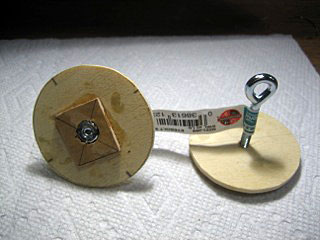
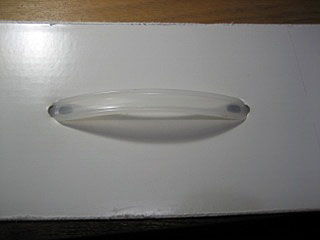




In the past when I traveled to a contest, I would pack everything into a large tool box -- “Big Red.” Lock it up and watch the petite ticket agent try to lift it onto the baggage conveyor. F2D is more standardized so I will be downsizing what I have to carry. The first thing to get downsized was the pit box. Greg has been using a soft-sided bag that I thought would serve for what I wanted.
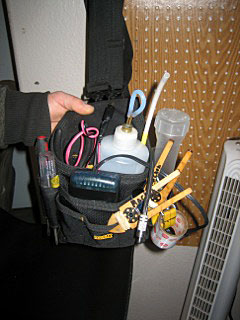
Gene had found one at Harbor Freight that he liked. I went online ordered one on Wednesday and it was in the Amazon locker on Thursday.
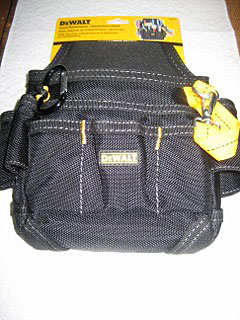
Next order of business is to go through hardware and see what needs to be added to. Once this is done, then an order to McMaster-Carr. All the bolts, nuts, and lock washers for the plane have been converted to metric. I realized that the metric nut driver that I had was too large. I also realized I needed some more metric bolts. The only USCS bolt is the 4-40 that connects the control horn to the pushrod.
I am waiting on Vasyl Yuvenko. On Jan. 6, Vasyl shipped me an order of shutoffs and a new handle that I want to use for the contest. After a month, the order had not shown up. USPS tracking shows it left Ukraine. After a month and a day, the package cleared U.S. Customs. A week later the package showed up with a large tear in the envelope and one of the shutoffs hanging out. Fortunately, no damage to the contents and all items were there.
I needed to build a proper blow tube. This is used to clear flooded engines. There is one advantage to having medical stuff done to your body: You get a lot of neat fittings and stuff for model airplanes. Greg uses the end of a ballpoint pen to make his blow tube. I used a fitting that was used during a medical test. To this I added an “O ring” and a piece of large latex tube. Seals tightly and works on the muffler end as well as the venturi.
I have dabbled for years with F2D planes and engines, but this year I decided to make a serious effort. I needed to get some competitive engines. I got three 2014 Foras from Yaro, along with props, lines, brackets that people told me I needed, heavier prop nuts to balance the planes.
Dabbling meant that I did not mess with mufflers. This year I have to deal with them. The new engines I purchased came with muffler holders. The problem is they do not work with the H&R external shutoff system. Jeffery sent me a photo of what he and Bill Maywald are doing to hold on mufflers. They are using aircraft safety wire and wrapping it neatly around the muffler and engine. I tried it using one piece of wire and found it difficult. Here is a pictorial of the method I used. Rather than aircraft safety wire I found some 19 gauge stainless steel at the local hardware. This is heavier than the aircraft safety wire. A word of caution if you are doing a bunch of these you may want to get some blood plasma because you are going to puncture yourself and bleed all over the place. The first thing to do is find a drill bit that matches the end of the muffler. The rest is self-explanatory.


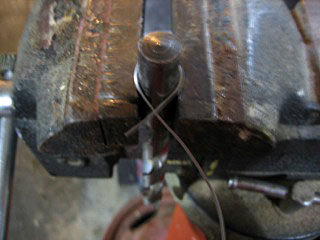



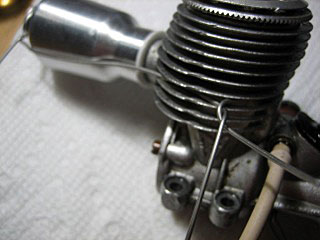



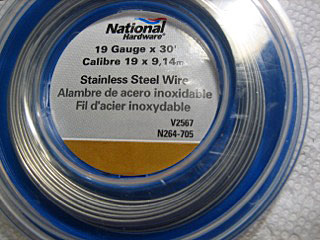
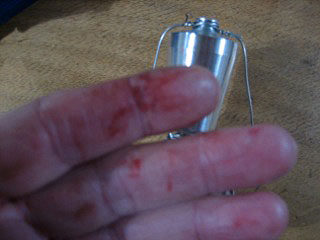
Much of the equipment is based on metric dimensions. From my dabbling days I have accumulated metric tools. To identify metric from USCS, I identified the metric by adding heat shrink tube.
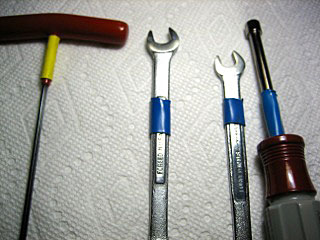
Flying two events (F2D Fast and FAI) and using the H&R shutoffs, I needed to make line sets. I decided I needed 10 sets. This is probably eight more sets than I need, but I am now ready for the Regionals as well. Now it has been raining. Imagine that -- rain in the Northwest. So for two days I put on rain gear and made line sets. These line sets are for two new adjustable handles that I got. I have F2D lines but they are for a different handle system and are too short for the new handle. The first problem, other than the rain, was not having enough line reels to store the new lines on. A little bit of house cleaning of bashed lines and I had reels. There are reels on order but not here yet. Well they are here, but the person who ordered them has not shown up with them. At the end of a wet cold day of line making I took a piece of scrap wire and attached and eyelet to it and picked up my new handle. &*$### the new handle is designed to hold the premade lines. I now have 10 sets of lines that will not go onto my new handles. I could bend the opening, but when I finish converting equipment over, then I risk work-hardening the metal and breaking the handles. As I have errands to run -- need to do a restock Costco run -- I am going to Michael's and get some jump rings to see if they might work as a connector. Well the jump rings were a total failure. The wire is way too soft. I have some very small scissor connectors that I have added to the handle. Next step is to make sure the lines are still with in tolerance.
To pack the planes, I need to alternate how they are stacked in the box. With the external push rods this creates a problem. To resolve the problem, I am identifying the pushrods to the plane and removing the control horn. Once I am in Phoenix, these will be reattached. The planes each have numbers and I took a Sharpie and placed marks on the rods that matched the plane. If you have metal control horns you can mark the plane number on the horn.
Now sometimes life gets in the way of getting ready for a contest. In this case two life events. I will not go into great detail. I am continually badgered for not updating my Mac software to the latest and greatest. The badger updated theirs and the computer locked up. This required spending a day lugging the computer to the Apple store and waiting all day. The second issue involves not flushing leftover stuff from the refrigerator down the toilet. In working on that problem, I discovered a cracked waste line under the house.
Over the years, dating back to buying F2D planes from Mejlik, I have an eclectic collection of F2D planes. Some of these have been tested while others have not. Many were converted for the H&R shutoff system. None had been run with mufflers. I started testing with a Profi with muffler and all was going well (a bad sign). When I went to test them with the new Foras, they would not fit in the muffler slot. The next issue to be overcome is the old planes are covered with the exploding covering as well as the covering that is not holding at the leading edge, trailing edge and wingtips. All solvable problems but they take time away from testing and flying. Small strips of Fascal have been added to the tips and trailing edges to secure the covering.
Many years ago, when I worked on small rocket motors for spy satellites, I gathered some interesting statistics. About 1 out of 10 would have problems that would follow it all the way through to being shipped. I watched countless hours and schedule being wasted in trying to keep the one sick engine moving along. I tried to convince people that there was a point in the process where it would be cheaper and quicker to start over than to continue trying to nurse a sick engine to completion. Model airplanes are no different. With limited time to test because of weather and wind, (written Feb. 16 with snow, rain, and winds for the next week) I am not going to waste time with a plane that wants to fly tip down after trying to dewarp it. I have pulled down another plane that has been flown but needs the muffler slot and covering corrections.
Snow is gone, leaving behind frozen ground. For those of you that watch Gold Rush, you may recognize the term. For the next group of plane, I suddenly had shutoff problems. Planes were shutting down in tight turns. I added additional tube thinking that would stop the problem but they were still there. I called the 1-800 shutoff helpline. The customer service rep, which by the way is the owner, asked a few questions and I now have a few things to check and retest.
As part of testing I marked out a 12-foot diameter and started to fly simulated matches. So far I am up two cuts to none on a fir tree, although they are leading edge cuts. The chain saw will be going for the kill. Slower RPM but longer length and greater pitch.
It is very cold and the engines do not like to start. To solve this problem, I take the heat gun and warm them up. Next I wrap a rag around them to keep them warm. Hook up the lines, check controls, fill bladder, and start to flip.
While prepping for testing, I discovered that the control horns were held on by a variety of fasteners. Time to standardize. Standardize = Order more stuff from McMaster Carr. This time it is bolts to hold on the elevator horns and a nut driver that works with the metric nylocks.
Before each flying season, which usually begins in April, I go through and check my equipment. This includes looking at the glow plug clip wiring. Every couple of years, the wiring will fail. This is the year for the wiring to fail at the glow plug clip. I was not looking for it but trying to restore life to some dead glow plugs when I discovered it.
The week of Feb. 18 has not been ideal for testing. Snow and wind with the occasional power outage for fun. I have one plane in the shipping box and stuff all over my workbench that I am trying to organize so that I can pack it. I should receive the last of the McMaster-Carr order the 23rd. As I have been doing work on pushrods, I found myself using a worn-out pair of flat nose pliers. Yet another opportunity to get a new tool.
Well, the McMaster-Carr order did not arrive, but more snow did. I was able to get three planes tested. Minor trim issues that were resolved by adding tip weights and nose weight. A fourth plane was tested, but has a warp that needs to be removed. It is two weeks before the contest and four planes are in the box and 4 inches of snow on the ground. This is the first time I have tested in the snow. Landings are interesting to watch.
With snow on the ground, three more planes were tested. Two made it into the shipping box while one is getting lead tape added to the leading edge.
Most of my flying is done in in the warmth and brightness of the sun. My flying site is surrounded with fir trees on 270 degrees. With the low sun angle and glasses that like to darken in the sunlight, I have been getting a lot of involuntary eyes off flying.
It is one week before leaving for Phoenix. Eight planes are packed. After testing today I will make the decision on the last two. Two items left to get ready. The first is to set up a fuel bottle. Actually I could not find a bottle but settled on a 24-ounce fuel tank. The second item is to organize the pit bag.
This concludes my part of the preparation for the contest.
-- Buzz
The next section is provided by Gene Pape.
I can’t remember which one of us started this. I’ve been wanting to go to March Madness for a few years and when I found out Buzz would be a willing partner I jumped at the chance. I had nine airplanes and two 2014 Foras left over from the years the C-Cup was for F2D fast so I thought I was set. I had the box they came in to haul them on the airplane and I had done some checking on flights. This was right around the first of the year and as near as I could tell I was set. Two months to check things out and get on a plane. What could go wrong?
I started by making sure I knew what I needed to know about traveling. I spent about a week looking at websites and going to the airport to ask questions. The good news was that they said I could check my model box with no problem (this has yet to be proven). The bad news was that having to fly a different airline than I first intended and adding the baggage fees, the cost about tripled.
After several emails to and from Buzz, a lot of the details of how to approach traveling by air to a contest started to come into focus. I knew I couldn’t carry all of the stuff I usually take to a contest for tools and spares, so I bought a tool bag from Harbor Freight and started figuring out how to set it up. I was about to start setting up what I thought would be a slick starting battery arrangement in my new pit bag. It occurred to me that anything I currently have or would like to have would look like a bomb to an airport scanner. I want to take along some kind of battery, but everything I use involves obvious batteries with wires attached to them. Probably not a good plan for something the TSA people would see only on a scanner in my luggage. After several weeks of thought, I think I have a plan for a battery that won’t get me arrested and what the other things I need are. I still don’t know after many hours of thought how to pack all of this without arousing the TSA people.
About the second weekend in January, I went out and test flew some of my models, with the plan being to dewarp them on the field. My inverter that I bought several years ago decided it didn't want to work anymore foiling my efforts to some degree. I did manage to test three models. I found a replacement on Amazon for $60.38 so I got one coming. The hitch was that it wouldn’t be here until the next week.
The following weekend I was able to finalize the testing of the models from the previous session and test two more. Now I have five of the seven models I intend to take tested and ready, a new inverter coming for setting up the last two, and I still have six weeks left. Life is good.
One of my engines seemed to be a bit down on power so I took it apart and checked the head clearance. It seemed a bit excessive, so I dropped the head to what I thought would be perfect and was all ready for testing the final two models the next weekend.
That’s when everything went right down the drain. In the middle of the week our 14-year-old miniature schnauzer became extremely ill. After two trips to the vet, it seemed as though we were going to have him put down on Saturday so no test flying for me. After more trips to the vet, we started to have some hope he would survive, so I went out to test the final two models. It was very windy, and one model was OK while the other was a real handfull. I stuck it straight into the ground.
Also, after a week of getting it properly set up, I found the new inverter I had just purchased didn’t work. The good news is that the dog is recovering. Also, I was able to repair the crashed model. The bad news is that the weather has gone to pot and I haven’t been able to test the final two models yet. There is one more chance to test them before the contest.
While all of the above was going on, I also discovered that all of the carry-on bags I have in my luggage supply were too big for current standards. Amazon to the rescue.
I now have a new carry-on bag and, I hope, everything I need to turn my model box into a piece of luggage. I think I’m going to make it.
-- Gene
Flying Lines home page
Back to Musings from the Pits main page
Back to Combat main page
This page was upated March 7, 2018
